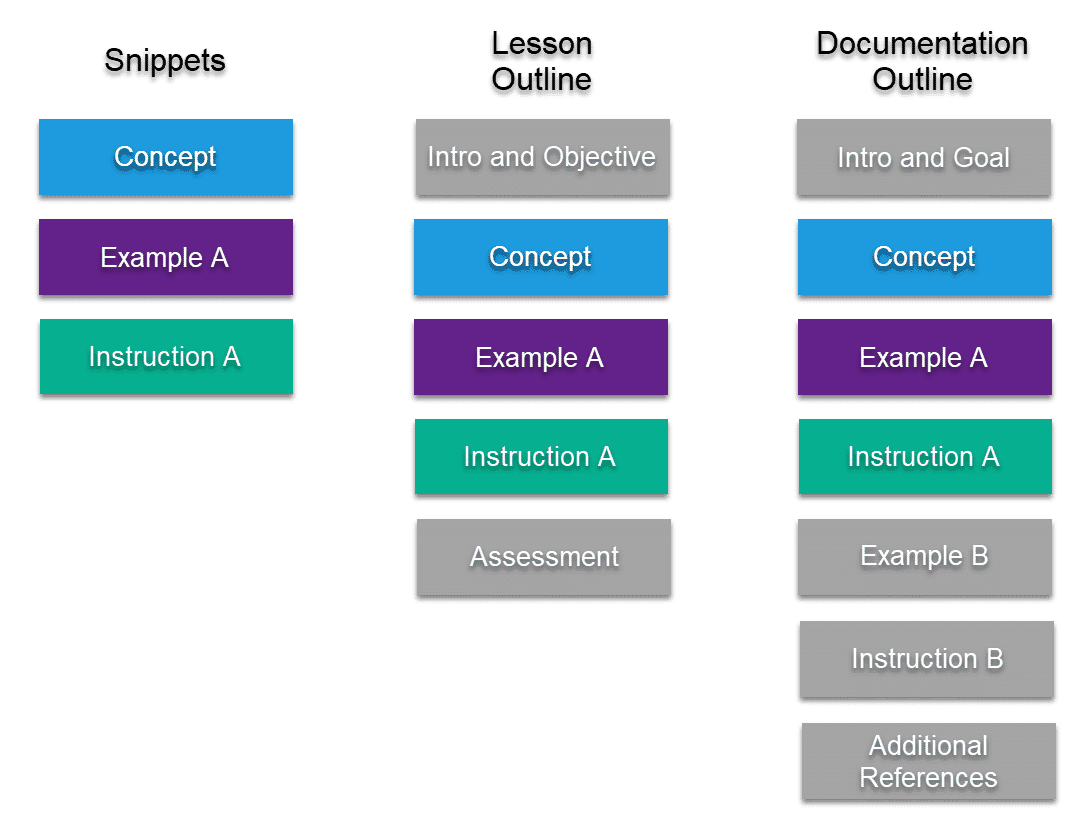This guest blog post was written by Jenni Christensen the Training and Technical Documentation Manager at PLEXSYS, a company with 40+ software applications supporting simulation and training in the defense industry.
I put on my noise-cancelling headphones and eagerly opened my browser, ready to review training options to educate our managers about training content best practices. Launching the course, I immediately cringe at the museum theme for lesson 1. I take a deep breath, click play and hope it’s not as bad as I fear. Lesson 2 is a zoo. In lesson 3, we’re underwater at an aquarium where the trainer casually, and with no irony at all, lectures on not using gimmicks like flashing text and irrelevant animation to create engagement... as their bullet points float up as bubbles out of a fish's mouth. I close my browser, lean back and sigh heavily—we’ll need to create our own course for this topic.
Quality content may be the single most essential aspect of a successful employee training program. Poor content will drain interest, engagement, and trust out of employees faster than bubbles floating out of a fish’s mouth. But how does one create that content to improve their training and development program for their employees?
For example, for software companies, managing the lifecycle of training content effectively is critical due to the constant evolution of software products and technologies. Employing software learning content management systems can significantly streamline the creation, management, and delivery of training materials, making it easier for teams to update and distribute content as needed.
Selecting or developing quality content and training material for employee development may feel daunting, so together we’ll look at how to identify and create quality content that engages and educates your employees. After learning to identify quality content, we’ll look at how we can develop content reuse strategies that leverage eLearning software and other technical writing software features, to utilize existing resources and reduce any associated cost concerns. If you’re ready to learn how to improve your employee training program, read on.
Identifying Quality Content
Identifying quality content requires recognizing when it relevantly engages, excites, and educates on a topic. It also requires learning to spot irrelevant engagement and excitement—like the carnival and aquarium themes from the introduction. While these themes and animations added flair and captured my attention, they were also incredibly distracting because they had nothing to do with the course topic. They captured attention and then misplaced it, which distracts the learner from the objective instead of enhancing it. Quality content will capture attention and focus it on the content, rather than distracting the learner from it.
In the next two sections, we’ll look at specific ways you can capture attention and focus it on the content to create more effective training material.
Be Relevant and Specific
Have you ever participated in a web security training where the instructor tells so many horror stories that at the end you don’t remember if you’re supposed to delete it, respond to it, click the link, or forward it to everyone so they know to click the link? Or wait, don’t click it! It was one of those two, right?
Or maybe you were in a cooking course learning to make your own pasta—yay! But then you’re shown five different ways to do the same thing—and now you don’t remember which steps went with which method, and, ugh, now you can’t even remember how to boil water.
It’s easy to want to make sure you cover everything when designing your content and employee training session. As content developers, we are so eager to share all our knowledge! But covering everything at once, particularly in a single training session, can lead to confusion.
Confusion happens when course content is not specific to the stated outcome of the course. So, to avoid confusion, ensure content focuses only on what matters to reach that specific goal.
Even for this article, I wanted to add all the things I’ve learned when designing a corporate training plan. Adding those in would have made the key points about quality content less clear. However, this information is still useful. Add related concepts as supplemental material—references, additional reading, or further courses. Just don’t directly address them in the course or lesson.
Retain Engagement with Interaction
Retain engagement? Yes. We need to start building engagement before an employee starts a training course. It’s an easy step to skip, but it’s one that makes a huge difference. Our focus is quality content—so check out the Additional Considerations section at the end to learn more about building employee engagement before a course starts.
Once we have engagement, we want to maintain it while the employee interacts with the course. There are simple, low investment and high-investment ways to do this. Use what works for your team and budget—high investment does not always mean better.
Simple ways to retain engagement include:
- Include graphics or animations. They should be relevant to the subject. Off-topic imagery distracts from the topic, even if it’s fun.
- Don’t discount fun. There is space for fun, but it’s at the beginning or end of a lesson, or as part of interactivity. And it must be relevant to the topic. (An aquarium theme will be distracting unless your course is about aquarium-related topics or you’re introducing yourself and you’re an aquarium enthusiast).
- Show the speaker or instructor. For videos, consider displaying the person talking, particularly when you have no relevant graphics.
- Ask questions and solicit interaction. These can be as simple or as complex as you can support. Simple, low investment ideas include:
- A pause with a yes/no type question that leads into the next idea in an interesting way.
- Survey questions that correspond to points in a lesson or course (if you don’t have the tech support to build this into your content directly).
- Maintain forums or chat rooms around a course topic to foster discussion.
More complex, higher investment engagement options include:
- Gamification. Either separate or connected to your LMS. For example, can employees earn points and win something for answering questions and participating in course activities? Can they earn badges, level up, or otherwise compete with themselves or each other?
- Simulation. A variety of simulation tools are becoming widely available and easier to use. Can your workplace support exploring VR or AR training? Can you use Digital Adoption Platforms to drive interaction with learning software directly? The tools in this space are growing quickly if you have the ability to implement them. Their capacity for engagement is very high.
Complex solutions can be fun, but they’re not required. Engagement is an area where something is always greater than nothing. Start with what you can implement today and look for ways to grow engagement in scope or complexity in the future.
Reuse Quality Content
Building engaging, relevant content, whether for training or for documentation, can be a time-consuming endeavor. That time often needs to be negotiated for in order to develop content at all.
As eLearning software tool adoption skyrockets across all industries, companies, and organizations, digital communication tools (like MadCap Flare) have opened the door to increased efficiency through digital content reuse for learning and documentation. Increased efficiency helps make the case for spending time and resources on content development because that investment reduces overhead.
Once your content is focused and specific, you enable content reuse across documentation and training teams. Unfortunately, these teams often work separately or haven’t considered single-sourcing their content in this way before, and so might be unsure how to start.
One way to get started is to use learning objectives for both training content and traditional documentation outputs like online help, user manuals, or internal documentation. This benefits teams and content in two ways:
- It’s easier to reuse because the purpose of the content is very specific and actionable and easily understood by all information developers.
- All teams will have at least a subset of the same content topics, despite their different contexts.
So, how can we organize content for reuse but also still present it for different audiences and intended uses?
Let’s look at an example that represents the strategy my own team uses. I’m going to use the term “snippet” which for my team represents the snippet feature in Flare, but, if you don’t use Flare, also refers to content that is identical in both contexts.
In the image below, we use snippets for the concept description, a related example, and an instruction set. We then reuse that as part of a lesson, and in a more comprehensive documentation topic.

The snippets of content represent a reduction in time spent because they’re only authored once and also reduce interaction with other team members while completing authoring activities.
Now, you might be thinking, “That’s great for written content, but how does that help with video or presentations?” My team uses snippets when authoring video scripts and adds transitional language in between conceptual, example, and instruction snippets.
Hopefully, these examples spark ideas for your own teams and process to explore ways you can reuse content between training and documentation.
Summary
While it’s easy to mistake flashy content (or do I mean fishy?) as engaging, interesting content, it often detracts from employee engagement in training courses. Choosing quality content is the most impactful way to improve your employee training program.
Quality content will have these characteristics:
- It’s relevant and specific to the topic or objective
- It retains employee engagement with at least simple interactive strategies
Once you have quality content, you’ll have the option to employ content reuse strategies to make content development more efficient.
Additional Considerations to Build Engagement Before a Training Course
Developing relationships will build trust, augmenting the value of relevant and interactive courses. And, before a course can be relevant for employees, you’ll need to identify what is relevant to them.
Having direct, two-way communication with employees builds relationships and helps identify what is relevant and needed. This engagement also affords the opportunity to explain the value of training that may not seem immediately applicable or valuable. It’s easy to settle with just communicating with employees via surveys or during a needs assessment (and these are valuable). However, this may also feel impersonal, especially if communication is limited to surveys.
Consider these strategies for direct communication:
- Small Companies - Have conversations with most or all employees about the training program and ask what they need or if they have feedback.
- Large Companies - Identify who is most influential, then ask for their thoughts and ideas directly as a proxy for talking to everyone.
- At random - Identify random employees who’ve recently taken a course and directly request their feedback.
From here, it might be tempting to build the training program and rely on surveys for further feedback. Instead, after implementing changes relevant to a conversation, continue the personal interaction by following up with the employees directly.
While some employees may be less forthcoming with critical feedback than on an anonymous survey, you’ll develop relationships that give people a reason to engage with training and provide productive feedback because they know you care about them.
When people feel cared about and listened to, it only enhances the effects of quality content in employee training programs. Leverage technology to improve employee training by using eLearning tools, technical documentation, training manual softwares and procedure manual softwares.










